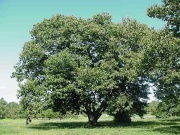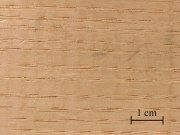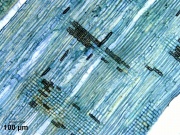Chestnut
Description
Deciduous trees of the genus Castanea, native to temperate zones in the United States, Europe, northern Africa and parts of Asia. The American chestnut, Castanea dentata, and the European chestnut, Castanea sativa, produce a light reddish brown wood that is relatively weak with a coarse grain. It is a soft light wood that splits easily but does not turn well. It is used for general construction, framing, fencing, poles and barrels. Chestnut wood was commonly used for painted panels, especially in Italy (Gettens and Stout 1966). Chestnut wood is also widely used to extract a vegetable tannin of the pyrogallol class. It has a low pH, low salts content, and produces a firm leather with a pale, reddish color. The extract from the bark of the chestnut tree has been used as a dye. Its dark color extracts were used in 19th century Italy and southern France to make an inexpensive fast black dye for silk.
Synonyms and Related Terms
American chestnut (Castanea dentata); European chestnut (Castanea sativa); Kastanje (Dan., Ned.); Edelkastanie (Deut.); castao (Esp.); chtaignier (Fr.); Kasztan (Pol.); castagno (It.)
Other Properties
Large tree growing over 30 m. Bark=smooth dark brown Leaves=simple ablong with veins and serrated edges. Flowers=tiny pale green in catkin (8-10 com long). Fruit=Large husk containing 2-3 shiny brown nuts.
Soft, lightweight wood with porous rings (specific gravity= 0.48). Wood is low in salts and high in acids.
| Density | 36-46 ppcf |
|---|
Hazards and Safety
Susceptible to worms. Highly acidic.
Additional Information
R. J. Gettens and G.L. Stout, Painting Materials, A Short Encyclopaedia, Dover Publications, New York, 1966. Schoch, W., Heller, I., Schweingruber, F.H., Kienast, F., 2004: Wood anatomy of central European Species: Sweet Chestnut, Castanea sativa Gaertn.
Additional Images
Authority
- R. J. Gettens, G.L. Stout, R. J. Gettens, G.L. Stout, Painting Materials, A Short Encyclopaedia, Dover Publications, New York, 1966
- G.S.Brady, G.S.Brady, Materials Handbook, McGraw-Hill Book Co., New York, 1971 Comment: p. 185
- Hermann Kuhn, Hermann Kuhn, Conservation and Restoration of Works of Art and Antiquities, Butterworths, London, 1986
- F. H. Titmuss, F. H. Titmuss, Commercial Timbers of the World, The Technical Press Ltd., London, 1965
- Matt Roberts, Don Etherington, Matt Roberts, Don Etherington, Bookbinding and the Conservation of Books: a Dictionary of Descriptive Terminology, U.S. Government Printing Office, Washington DC, 1982
- Dictionary of Building Preservation, Ward Bucher, ed., John Wiley & Sons, Inc., New York City, 1996
- Pam Hatchfield, Pam Hatchfield, Pollutants in the Museum Environment, Archetype Press, London, 2002
- Website address 1, Website address 1 Comment: Virginia Tech Dendrology website at www.fw.vt.edu/dendro/dendrology/main.htm (accessed Oct. 8, 2005)
- Wikipedia, the free encyclopedia, at http://www.wikipedia.com Comment: http://en.wikipedia.org/wiki/Chestnut (Accessed Oct. 8, 2005)
- Van Nostrand's Scientific Encyclopedia, Douglas M. Considine (ed.), Van Nostrand Reinhold, New York, 1976
- Random House, Random House, Webster's Encyclopedic Unabridged Dictionary of the English Language, Grammercy Book, New York, 1997
- The American Heritage Dictionary or Encarta, via Microsoft Bookshelf 98, Microsoft Corp., 1998




